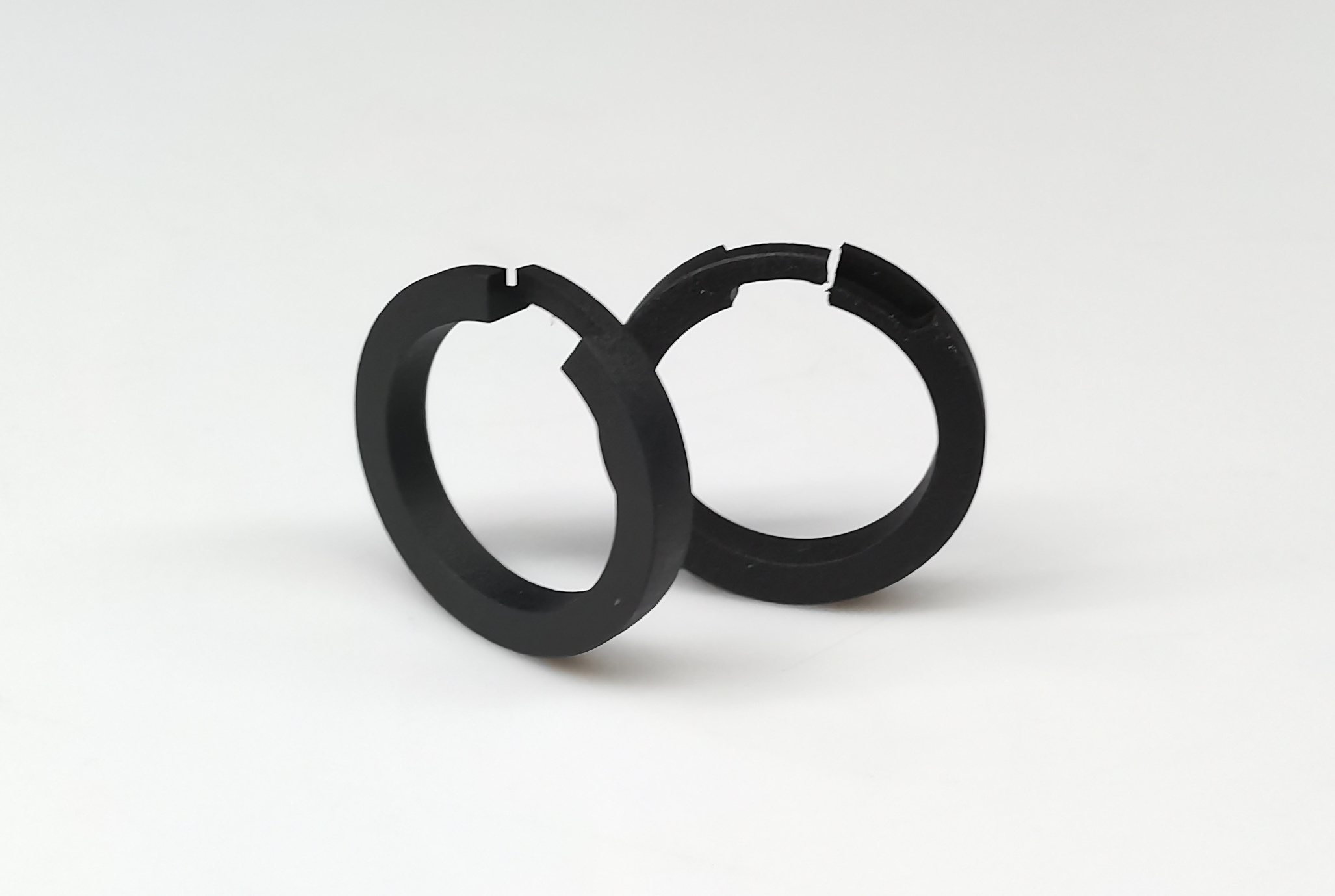
In demanding industrial environments, the performance of seals directly impacts equipment reliability, efficiency, and operating costs. Traditional pure Polytetrafluoroethylene (PTFE) holds a significant position due to its exceptional chemical resistance and low coefficient of friction. However, its inherent cold flow (creep) and insufficient wear resistance limit its application in high-parameter operating conditions. A composite material combining a PTFE matrix, carbon fibers (CF), and molybdenum disulfide (MoS₂) has emerged, significantly enhancing the overall performance of seals and becoming the ideal choice for demanding applications.
I. Material Composition and Synergistic Effects
- PTFE Matrix: Provides core chemical inertness (resistant to virtually all strong acids, bases, solvents, and oxidizers), broad temperature adaptability (-200°C to +260°C), and one of the lowest dry coefficients of friction in the material family (starting as low as 0.04).
- Carbon Fiber (CF): Key structural reinforcement. Long or chopped carbon fibers embedded in the PTFE matrix dramatically improve:
- Compressive Strength & Dimensional Stability: Significantly reduce cold flow deformation, maintaining sealing surface pressure.
- Thermal Conductivity: Improved by orders of magnitude compared to pure PTFE, facilitating friction heat dissipation and reducing thermal stress and local overheating risks.
- Rigidity: Enhances resistance to extrusion (especially in high-pressure conditions).
- Molybdenum Disulfide (MoS₂): A classic solid lubricant, providing core lubrication:
- Layered Structure Sliding: MoS₂ lamellae slide easily under shear force, providing an exceptionally low and stable dynamic coefficient of friction (can be reduced to 0.1-0.15).
- Wear Scar Filling & Transfer Film Formation: Effectively coats the metal counterpart surface, reducing adhesive wear.
- Synergistic Enhancement: Works in concert with carbon fibers, forming a composite anti-wear system of “skeleton support + efficient lubrication”.
The synergy of these three materials is not a simple functional addition but achieves a performance leap where 1+1+1 > 3.
II. Core Structural Features and Performance Advantages
- Ultra-High Strength and Superior Dimensional Stability:
- The high modulus of carbon fibers reinforces the PTFE skeleton like steel rebar, increasing its creep resistance manifold.
- Under high pressure (up to 40 MPa or higher), prolonged load, or temperature fluctuations, the seal cross-section retains its shape effectively, preventing seal failure and gap extrusion – a level unattainable for pure PTFE.
- Exceptional Wear Resistance and Extended Service Life:
- Composite Lubrication Mechanism: MoS₂ provides a base lubricating layer, while carbon fibers share the load and inhibit excessive plastic flow and material transfer of the PTFE matrix, significantly reducing adhesive and abrasive wear in the friction pair.
- High PV Limit: The load-bearing capacity (P) and permissible sliding speed (V) product for the composite far exceeds that of pure PTFE or PTFE filled only with graphite or glass fibers. It readily handles high-speed reciprocating motion (e.g., hydraulic rod seals) or medium-speed rotation (e.g., pump shaft seals).
- Life Extension: In practical applications, service life is typically several times to even tens of times longer than pure PTFE or glass-filled PTFE seals, drastically reducing downtime for replacements and maintenance costs.
- Very Low Dynamic Coefficient of Friction:
- The inherent lubricating properties of MoS₂ dominate the reduction in friction coefficient, providing stable low friction even without sufficient oil film lubrication or under dry conditions (e.g., start-stop phases).
- Low friction translates to low running resistance, reduced energy consumption (improved system efficiency), and lower heat generation, which is critical for high-speed and high-PV applications.
- Excellent Thermal Conductivity and Stability:
- The high thermal conductivity of carbon fiber (orders of magnitude higher than PTFE) acts like built-in high-speed heat dissipation channels, rapidly removing friction interface heat to prevent local overheating, material softening, and accelerated wear.
- Even under high-temperature conditions (close to PTFE’s 260°C limit), the composite retains sufficient strength and dimensional stability, whereas creep in pure PTFE dramatically intensifies at this temperature.
- Comprehensive Chemical Corrosion Resistance:
- It inherits the excellent chemical inertness of pure PTFE, while carbon fibers and MoS₂ themselves also exhibit good chemical resistance. This allows composite seals to be safely used in the vast majority of corrosive media, including acids, alkalis, salts, and organic solvents.
- Broad Temperature Adaptability:
- In extreme cold environments (e.g., -50°C or lower cryogenic equipment), it does not become brittle; under continuous high temperatures (up to 260°C), it maintains performance stability. This wide-spectrum adaptability makes it particularly suitable for applications with drastic temperature changes (e.g., heating during compression) or specific temperature ranges (e.g., aerospace, cryogenic pumps/valves).
III. Key Application Areas
This high-performance composite sealing material is suitable for extremely demanding locations where maintenance is difficult or long life with minimal maintenance is desired. Typical applications include:
- Heavy-Duty Industrial Hydraulics: High-pressure cylinder piston/piston rod seals, wear rings (especially under high PV values and side load conditions).
- Gas Compression/Transmission: Compressor (including oil-free) piston rings, packing seals, valve seals (withstand high-temperature, high-pressure gas).
- Chemical Process Pumps & Valves: Rotary shaft seals, valve stem seals (resistant to aggressive media, high-speed rotation).
- Energy Equipment: Oil & gas drilling/production equipment seals, Liquefied Natural Gas (LNG) cryogenic pump/valve seals.
- High-Performance Vehicles: Seals for hydraulics and pneumatics in race cars and construction machinery.
- Aerospace & Semiconductor: Seals requiring ultra-high cleanliness, resistance to space-environment media, or special gases.
IV. Manufacturing and Application Considerations
- Precision Processing: Pre-mix homogeneity, injection molding temperature/pressure control, and precise sintering curves are crucial for final product performance.
- Anisotropy: Particularly for long-fiber reinforced materials, performance varies by direction (along vs. perpendicular to fiber orientation); design must consider load direction and assembly.
- Installation: Ensure seal groove design is rational with high surface finish. Install carefully to avoid damaging the sealing lip. If allowed, applying a compatible lubricating grease moderately can aid initial startup.
Media Contact
Company Name: Guangdong DLSEALS Technology Co., Ltd.
Email: Send Email
Country: China
Website: https://www.dlseals.com/





